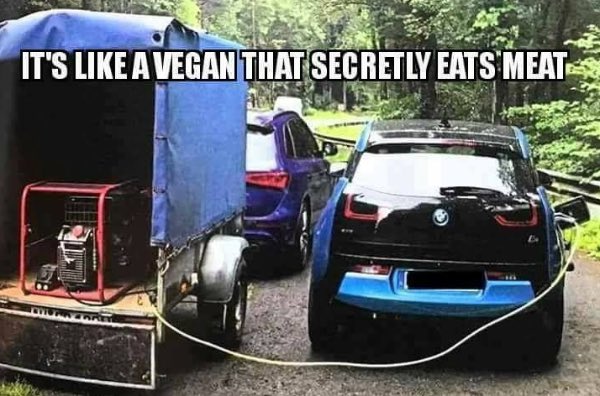The Perfect Meme Debunking Renewable Energy
Sometimes a picture is worth a thousand words. The meme below shows an electric car being charged by a portable electricity generator, which runs on fossil fuels. This meme is a perfect analogy for what happens to our electricity system when intermittent renewable sources of electricity are added to the grid. Let me explain:

Electric cars and renewable energy both suffer from the same problem: limited availability. For electric cars, this is manifested in limits on battery storage, which limits the miles that can be traveled in the cars without having to be recharged.
For renewables, their limited availability stems from the fact that their “fuel sources” (i.e. wind energy and sunlight) are unpredictable, and sometimes they provide no energy at all.
These challenges can be overcome, in most cases, but the so-called solutions are expensive, cumbersome, and probably do very little to help the environment.
Imagine these two cars represent the electric grid. The car on the left is a coal or gas plant, and the car on the right is a wind or solar plant.
The car on the left would be perfectly suitable for going wherever you’d want to go by itself. The fuel would be widely available, and the engine runs most efficiently on the highway when it does not need to start and stop.
However, because the car on the right has limited availability, the car on the left must be ready to compensate for it by hauling a fossil-fuel powered generator behind it. This significantly reduces the gas mileage of the car on the left by adding extra weight, and increasing the drag etc.
Obviously, this increases the cost of operating the car and its environmental footprint.
This is similar with power plants.
The intermittent nature of wind and solar power means that coal or natural gas power plants must be ready to compensate for them, increasing electricity output when wind or solar are unavailable, and decreasing output when wind and solar are generating electricity.
Starting and stopping electricity production, a process called “ramping,” reduces the efficiency of power plants the same way stop-and-go traffic reduces gas mileage in cars. Coal and gas power plants would have to do significantly less ramping (and bear fewer of the costs associated with it) if not for the unpredictable nature of wind and solar electric plants.
There is also the up-front cost of buying needing to buy two cars, instead of one, to consider:
Regardless of the fuel type, having to own and operate two cars for every trip instead of one would necessarily increase the cost of going anywhere.
Even if you only drove the car on the left to a central destination as a “home base,” and drove the electric car from there, you would still be incurring fixed costs on the car on the left, such as insurance, registration, car payments etc.
In fact, you’d be paying these fixed costs for both cars. In the end, you can have both cars, but with significantly more hassle and expense for the same mobility.
And that is a glimpse into why intermittent renewable energy sources make electricity more expensive.